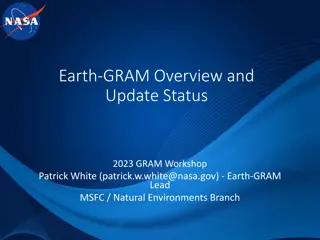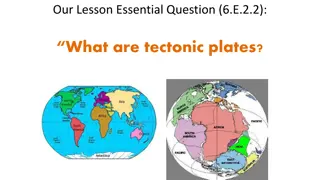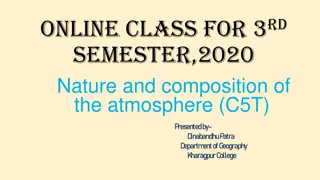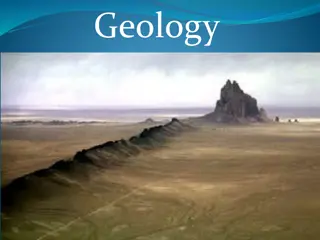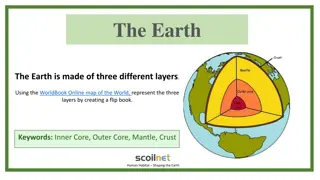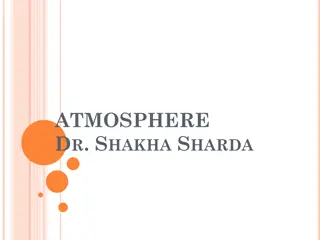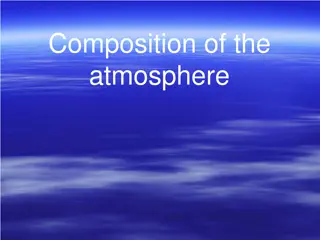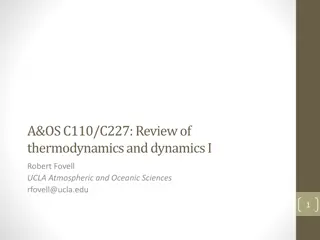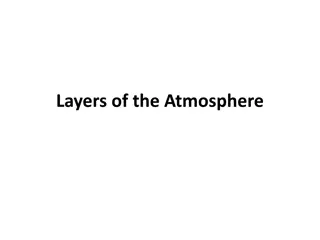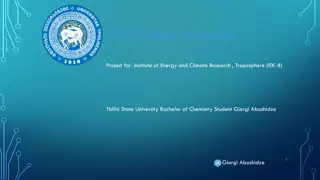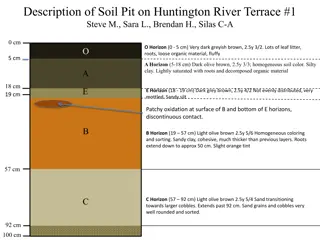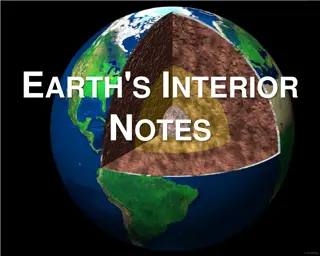Understanding Earth's Atmosphere Composition and Layers
Earth's atmosphere is primarily composed of nitrogen and oxygen, with other gases like argon, CO2, and water vapor making up the remaining percentage. While the levels of nitrogen and oxygen remain constant, variable gases like water vapor fluctuate based on location and time. CO2 levels have been increasing due to human activities like burning fossil fuels. The ozone layer, crucial for absorbing radiation, has been depleting due to chlorofluorocarbons (CFCs). The atmosphere also contains a mix of solids like dust, salt, and ice, as well as microorganisms. The atmosphere is divided into layers like the troposphere and stratosphere, each with distinct characteristics.
Download Presentation

Please find below an Image/Link to download the presentation.
The content on the website is provided AS IS for your information and personal use only. It may not be sold, licensed, or shared on other websites without obtaining consent from the author. Download presentation by click this link. If you encounter any issues during the download, it is possible that the publisher has removed the file from their server.
E N D
Presentation Transcript
Chapter 11 The Atmosphere
Atmospheric Composition 99% of the atmosphere is made up of nitrogen and oxygen. The other 1% is mostly argon, CO2, and water vapor
The amount of oxygen and nitrogen does not change much over time. Variable gases DO change from time to time and place to place. Ex. Water vapor is high over the oceans and lower over deserts.
CO2acts as a greenhouse gas and has been increasing in the past 150 years. Probably due to the increasing amount of fossil fuel being burned.
Ozone forms a layer 20 50 km above Earth. Ozone is important because it absorbs radiation. It has been decreasing lately. The decrease is due to chlorofluorocarbons (CFC s)
The atmosphere also contains variable amounts of solids. These are very small pieces of dust, salt, and ice. It can even include bacteria and fungi and other microorganisms.
Atmospheric Layers 1. Troposphere the lowest layer. - contains most of the mass of the atmosphere. - weather occurs in this layer - temperature decreases as altitude increases. - the area where the temp stops decreasing is called the tropopause. (-60C)
2. Stratosphere just above the tropopause. -Temps increase with altitude -Contains the ozone layer -Ozone increases temp by absorbing U.V. radiation
- the temp stops increasing at the stratopause. -The stratopause is about 50 km above Earth s surface. 99.9% of the atmosphere s mass is below the stratopause.
3. Mesosphere - 50 85 km above the surface. - temps decrease with altitude. - the top of the mesosphere is called the mesopause
4. Thermosphere between 85 600 km. - extremely low density - temps can exceed 2000 C. - contains the ionosphere which is a layer of electrically charged particles.
Exosphere -outermost layer of the atmosphere. - 600 10,000 km. - top of the exosphere is outer space. - extremely low density
ENERGY TRANSFER! There are three main type of thermal energy transfer. Radiation Conduction Convection (thermal energy is the energy of particles in motion)
Radiation the transfer of thermal energy by electromagnetic waves. Ex. Heat lamps. Thermal energy is transferred from the sun to the Earth by radiation. This radiation is absorbed and reflected by the Earth s surface and atmosphere.
About 30% of the solar radiation is reflected back into space by the Earth s surface, atmosphere or clouds. 20% is absorbed by the atmosphere and clouds. 50% is absorbed by the Earth s surface and keeps the Earth warm.
Different areas absorb radiation at different rates. Water heats and cools more slowly than land . Dark objects heat faster than lighter objects.
Conduction the transfer of thermal energy between objects when their atoms or molecules collide. Occurs more easily in solids and liquids. Why? Occurs between the surface and the lowest part of the atmosphere.
Convection the transfer of thermal energy by the movement of heated material from one place to another. Warm air rises where it cools, cool air sinks where it is heated by the surface. These are called convection currents and are the main way energy is transferred in the atmosphere.
Section 2 Properties of the Atmosphere Temperature the measure of the average kinetic energy in the particles in a substance. More kinetic energy = particles moving faster = higher temperatures
There are three main scales used to measure temperature. Fahrenheit Celsius Kelvin The Fahrenheit and Celsius scales are based on the freezing and boiling points of water.
The Kelvin scale is based on absolute 0 which is the coldest anything can be.
C + 273 = K Air Pressure the pressure exerted on a surface by the weight of the atmosphere above the surface. Pressure = force divided by area. Measured in Newtons/m2 or in millibars (mb)
1 mb = 100 N/m2 At sea level the atmosphere exerts a pressure of 1000 mb. As altitude increases, air pressure decreases.
Air density decreases as altitude increases. Air density increases as altitude decreases. Air pressure decreases as altitude increases. Air pressure increases as altitude decreases.
Temperature inversion an increase in temperature with height in an atmospheric layer resulting in warmer air on top of cooler air. Effects are an increase in for or low clouds.
In large cities an inversion can worsen air pollution because the cooler, polluted air is trapped under the warmer air layer on top. Smog = smoke + fog
Air moves from areas of high pressure to areas of low pressure. This movement is called wind! Wind speed and direction change with height in the atmosphere. Near the surface wind is slowed by friction between the air and surface objects like trees and buildings.
At higher altitudes wind speed increases. Wind speed is usually measured in miles per hour. At sea it is measured in knots. 1 knot = 1.15mph
Humidity the amount of water vapor in the atmosphere at a given location on the Earth s surface. It can be expressed as relative humidity or dew point.
Water is evaporating from the surface into the atmosphere where it condenses and forms clouds and precipitation. When the air is holding all the water vapor it can it is said to be saturated.
The amount of water vapor in the air relative to the amount of water vapor needed for it to be saturated is called relative humidity. Relative humidity is expressed as a percentage. 50% relative humidity means the air is holding the amount of water vapor it can.
Most people are comfortable with a relative humidity of 45%. Dew point the temperature to which air must be cooled at constant pressure to reach saturation. When the temperature reaches the dew point water vapor condenses and dew forms.
If the dew point and the air temp are about the same then the relative humidity is high.
As water vapor condenses the thermal energy that was added to evaporate it is released. The excess thermal in water vapor as opposed to liquid water is called latent heat. When condensation occurs latent heat is released and warms the surrounding air.
Section 3 Clouds and Precipitation Cloud Formation Water vapor is the source of clouds and rain. The cooling of an air mass as it rises can cause water vapor in the air mass to condense.
A condensation nucleus is a small particle in the atmosphere around which water droplets can form. These particles are extremely small and can be made of dust, ice, salt, etc. When the droplets get large enough to be visible a cloud is formed.
An air mass will rise as long as it is warmer than the air around it. Sometimes it will begin to rise but sinks back to its original place. This is considered a stable air mass because it resists rising. An air mass with high stability resists rising.
Fair weather clouds will form in stable atmospheres. Unstable air mass produce clouds associated with thunderstorms.
Atmospheric lifting clouds can form when air is forced upward by mechanical processes. This is called orographic lifting. It occurs when an air mass is forced to rise over a barrier like mountains. The rising air mass expands and cools and condenses.
This is why the windward side of mountains can be some of the rainiest places on Earth. When two different air masses collide with each other from different directions it is called convergence.
When a warm air mass and a cooler air mass converge the warmer less dense air is forced over the cooler more dense air. As the warm air rises it can cool and form clouds.
Types of clouds Low clouds (below 2000 meters) usually flattened on top Cumulus and stratus clouds Stratus clouds form grey, thin sheets. Often forms when fog lifts.
Middle clouds (2000 6000 m) Altocumulus and altostratus Made up of ice crystals and water droplets. Usually layered. Altostratus have a grey appearance and form thin sheets.
High clouds (above 6000 m) Made of ice crystals Cirrus have wispy appearance Cirrostratus forms a continuous layer in the sky Cirrocumulus have a rippled appearance
Precipitation all forms of water that falls from clouds to the ground. Coalescence occurs when cloud droplets collide and join together to form larger droplets. Rain drops typically have diameters between 0.5 and 5 mm.
Sometimes air currents cause droplets to move up and down through freezing and nonfreezing air forming ice pellets called sleet. Sleet can also occur when rain droplets freeze as they fall through freezing air near the surface.




